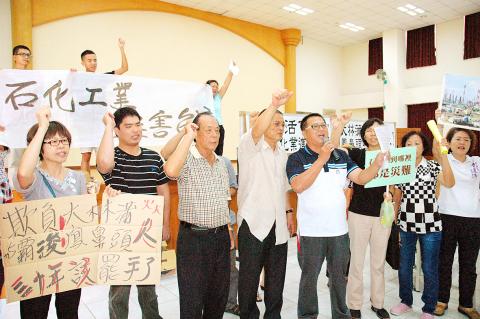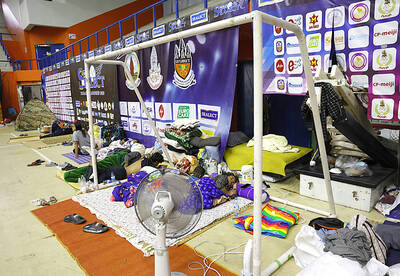Dozens of residents of Greater Kaohsiung’s Siaogang District (小港) yesterday rallied outside state-run Chinese Petroleum Corp, Taiwan’s (CPC, 中油) Dalinpu (大林埔) activity center to protest against the Ministry of Economic Affairs plan to relocate the city’s petrochemical plants to a proposed land-reclamation area covering more than 400 hectares.
In response to the public outcry demanding that the plants be moved to sparsely populated areas to ensure public safety, Minister of Economic Affairs Woody Duh (杜紫軍) on Friday last week said that the ministry is considering moving the petrochemical plants in the Renda Industrial Area to a landfill adjacent to Siaogang District, which forms a part of the 3,000 hectare South Star Plan.
The relocations could be carried out as soon as 2017, according the plan’s timetable, Duh said.

Photo: Fang Chih-hsien, Taipei Times
Fongsing Borough (鳳興) Warden Hung Fu-hsien (洪富賢) said that the proposed relocations would endanger the health and safety of more than 19,000 residents of the city’s six seaside boroughs — Fongsing, Longfong (龍鳳), Fongyuan (鳳源), Fongming (鳳鳴), Fonglin (鳳林) and Fongsen (鳳森).
He said that residents would continue to oppose the plan until a relocation proposal is provided by the ministry and called on the authorities to uphold “residential justice.”
Taiwan Water Conservation Union deputy director-general Chiu Chun-hua (邱春華) said that even though the landfill is listed as a reserved site for a free-trade harbor, it was actually set aside for the establishment of a petrochemical zone.
The government and Taiwan International Ports Corp had planned all along to set up the zone, she said.
“Even before the gas pipeline explosions, I saw on the company’s Web site a blueprint of the South Star Plan. It showed that the entire Nangsing Road, off the No. 7 freight wharf, had been allocated as a petrochemical zone,” she said.
“We strongly oppose any development in this district before the competent authorities carry out thorough assessments of health risks and possible endemics that the pollutants and toxic substances could cause,” Chiu added.
Chiu called on Kaohsiung Mayor Chen Chu (陳菊) to deliver on her promise to Dalinpu residents to look out for their rights and best interests when she meets with Premier Jiang Yi-huah (江宜樺) on Friday.
Relocating the petrochemical plants in the city is reportedly on the agenda of that meeting.

The US government has signed defense cooperation agreements with Japan and the Philippines to boost the deterrence capabilities of countries in the first island chain, a report by the National Security Bureau (NSB) showed. The main countries on the first island chain include the two nations and Taiwan. The bureau is to present the report at a meeting of the legislature’s Foreign Affairs and National Defense Committee tomorrow. The US military has deployed Typhon missile systems to Japan’s Yamaguchi Prefecture and Zambales province in the Philippines during their joint military exercises. It has also installed NMESIS anti-ship systems in Japan’s Okinawa

‘WIN-WIN’: The Philippines, and central and eastern European countries are important potential drone cooperation partners, Minister of Foreign Affairs Lin Chia-lung said Minister of Foreign Affairs Lin Chia-lung (林佳龍) in an interview published yesterday confirmed that there are joint ventures between Taiwan and Poland in the drone industry. Lin made the remark in an exclusive interview with the Chinese-language Liberty Times (the Taipei Times’ sister paper). The government-backed Taiwan Excellence Drone International Business Opportunities Alliance and the Polish Chamber of Unmanned Systems on Wednesday last week signed a memorandum of understanding in Poland to develop a “non-China” supply chain for drones and work together on key technologies. Asked if Taiwan prioritized Poland among central and eastern European countries in drone collaboration, Lin

Renewed border fighting between Thailand and Cambodia showed no signs of abating yesterday, leaving hundreds of thousands of displaced people in both countries living in strained conditions as more flooded into temporary shelters. Reporters on the Thai side of the border heard sounds of outgoing, indirect fire yesterday. About 400,000 people have been evacuated from affected areas in Thailand and about 700 schools closed while fighting was ongoing in four border provinces, said Thai Rear Admiral Surasant Kongsiri, a spokesman for the military. Cambodia evacuated more than 127,000 villagers and closed hundreds of schools, the Thai Ministry of Defense said. Thailand’s military announced that

CABINET APPROVAL: People seeking assisted reproduction must be assessed to determine whether they would be adequate parents, the planned changes say Proposed amendments to the Assisted Reproduction Act (人工生殖法) advanced yesterday by the Executive Yuan would grant married lesbian couples and single women access to legal assisted reproductive services. The proposed revisions are “based on the fundamental principle of respecting women’s reproductive autonomy,” Cabinet spokesperson Michelle Lee (李慧芝) quoted Vice Premier Cheng Li-chiun (鄭麗君), who presided over a Cabinet meeting earlier yesterday, as saying at the briefing. The draft amendment would be submitted to the legislature for review. The Ministry of Health and Welfare, which proposed the amendments, said that experts on children’s rights, gender equality, law and medicine attended cross-disciplinary meetings, adding that